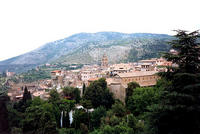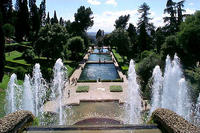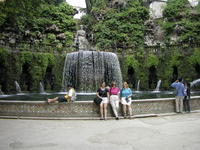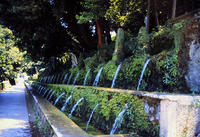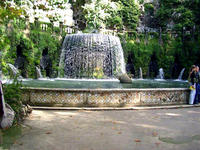You are in: Europe -> Italy -> Villa d’Este, Tivoli, and traditional search or Image Gallery will yield results of this site only
Villa d’Este, Tivoli
| Site number: | 1025 |
|
| Type of site: | Cultural | |
| Date: | 16th-century | |
| Date of Inscription: | 2001 | |
| Location: | Europe, Italy, Province of Rome, Region of Latium | |
Up to 75 images are shown here. Click on each for more details or on Image Gallery for more images.
| Description: | The Villa d'Este in Tivoli, along with its palace and garden, constitutes one of the most noteworthy and comprehensive demonstrations of Renaissance culture at its height. The garden’s modern design together with its architectural components, such as the fountains, ornamental basins, and others, makes this a matchless illustration of an Italian 16th-century garden. The earliest example of a garden of miracles(giardini delle meraviglie), Villa d'Este served as a model for the development of European parks and gardens. --WHMNet paraphrase from the description at WHC Site, where additional information is available. | |
| The Villa d'Este is a villa situated at Tivoli, near Rome. Listed as a UNESCO world heritage site, it is a masterpiece of Italian architecture and especially garden design. The Villa d'Este was commissioned by Cardinal Ippolito II d'Este (1509-1572), son of Alfonso I d'Este and Lucrezia Borgia and grandson of Pope Alexander VI. He had been appointed Governor of Tivoli by Pope Julius III, with the gift of the villa, which he had entirely reconstructed to plans of Pirro Ligorio under the direction of the Ferrarese architect-engineer Alberto Galvani, court architect of the Este. The chief painter of the ambitious internal decoration was Livio Agresti from Forlì. From 1550 until his death in 1572, when the villa was nearing completion, he created a palatial setting surrounded by a fabulous terraced garden in the late-Renaissance mannerist style, which took full advantage of the dramatic slope but required innovations in bringing a sufficient water supply, which was employed in cascades, water tanks, troughs and pools, water jets and fountains, giochi d'acqua. Other noted villas with water-play structure are the Villas Aldobrandini and Torlonia in Frascati. --Wikipedia. Text is available under the Creative Commons Attribution-ShareAlike License. | ||
| Source: | http://whc.unesco.org/en/list/1025 | |
| Reference: | 1. UNESCO World Heritage Center, Site Page. | |


